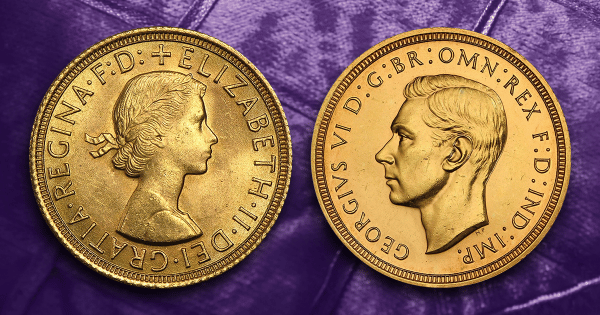The passing of Queen Elizabeth II on September 8th, 2022 was felt around the world
The Queen was beloved by many, and her death will result in changes that have not occurred since she took the throne 70 years ago at the age of 25.
A significant shift in the next few years will impact the appearance of currency used not just in the United Kingdom, but in at least 20 other countries. Her visage has graced the coinage and banknotes used around the world, and now with the change in the monarchy the likeness of her son, Charles, will replace hers.
The Future Face of Commonwealth Currency
The question many have been asking is when this change in portraiture will happen on popular coins and currency. While there have been no official announcements from the Royal Mint, the tradition has been for the new ruler’s profile to face the opposite direction of their predecessor’s, so King Charles III’s portrait will likely face to the left. The Royal Mint has reported that it has not stopped striking coins with Queen Elizabeth II’s portraiture and that all coins bearing her likeness are still legal tender.
A five-pound Silver coin was released from the Royal Mint to commemorate Prince Charles III’s 70th birthday in 2018 that features his portrait, so it could be likely that they use the same or a similar likeness on new coinage forward.
However, an official portrait has yet to be commissioned for new banknotes and stamps, so it may be a while before we see King Charles III on U.K. currency.
The Royal Australian Mint and the Perth Mint have stated that they plan to use King Charles III’s new effigy on coins dated 2023 and are collaborating with the U.K. Royal Mint to determine the obverse’s new appearance. During this transition period they will continue to release 2022 dated coins with the late Queen’s effigy.
It could take several years before King Charles III is seen on all Commonwealth coins, and there may be a period where King Charles III and his mother will both be on circulating coins until the late Queen is totally phased out. Since many coins and currency have already been manufactured for 2022, some mints and banks have reported that they will not be producing currency featuring the new monarch until next year. For example, the Reserve Bank of New Zealand has stated that it would eventually replace Queen Elizabeth II’s face but only after its stores of printed $20 banknotes are exhausted to prevent needless waste.
The Reserve Bank of Australia will also keep its five Australian banknotes for years on similar grounds—that currency has already been produced. However, in their situation, the King will start circulating as soon as 2023 on coins and potentially on the lowest denomination of banknote. On a similar note, the Bank of Canada has also announced that the $20 banknote with the Queen’s likeness will circulate in the coming years, although, it will be up to the Canadian government if King Charles III’s portrait will replace hers.
It will be interesting to see how each mint and bank will adapt to this transition period, and it will differ based on each Commonwealth country.
The Countries Who Might See This Change
The Commonwealth of Nations, also referred to as the Commonwealth, consists of 56 independent states that were at once British Empire territories and encompasses a quarter of the world’s population. Those in the Commonwealth share the same language and comparable systems of government and are led by the British monarch in power and the Head of State in the U.K.
The members of the Commonwealth include: Antigua and Barbuda, Australia, The Bahamas, Bangladesh, Barbados, Belize, Botswana, Brunei, Cameroon, Canada, Cyprus, Dominica, Eswatini, Fiji, Gabon, Gambia, Ghana, Grenada, Guyana, India, Jamaica, Kenya, Kiribati, Lesotho, Malawi, Malaysia, Maldives, Malta, Mauritius, Mozambique, Namibia, Nauru, New Zealand, Nigeria, Pakistan, Papua New Guinea, Rwanda, St. Kitts and Nevis, St. Lucia, St. Vincent and the Grenadines, Samoa, Seychelles, Sierra Leone, Singapore, Solomon Islands, South Africa, Sri Lanka, Tanzania, Togo, Tonga, Trinidad and Tobago, Uganda, United Kingdom, Vanuatu, and Zambia.
Although there has been talk among some leaders of these countries that they will leave the Commonwealth with the Queen gone, it is highly unlikely that the Commonwealth will dissolve. Therefore, these countries are all likely to experience some change in who appears on their currency based on Queen Elizabeth II’s passing.
The Future of Queen Elizabeth II Coins
Coins depicting the late Queen are still very common and easy to find right now, but as they begin to transition out their collectability may grow in the coming years. Coin collections that have already seen a spike in popularity are collections with each of the Queen’s five distinct portraits. Based on this it might interest coin collectors to secure some of these coins now while they’re easy and accessible to purchase before they stop circulating.





